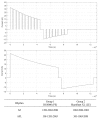Cardioversion of Atrial Fibrillation and Flutter: Comparative Study of Pulsed vs. Low Energy Biphasic Truncated Exponential Waveforms
- PMID: 32435331
- PMCID: PMC7237103
- DOI: 10.4022/jafib.2172
Cardioversion of Atrial Fibrillation and Flutter: Comparative Study of Pulsed vs. Low Energy Biphasic Truncated Exponential Waveforms
Abstract
Background: Despite the widespread use of biphasic waveforms for cardioversion and defibrillation, the efficacy and safety of shocks has only been compared in a few studies.
Methods: This retrospective study aims at comparing the efficacy and safety of biphasic truncated exponential (BTE) pulsed energy (PE) waveform with a BTE low energy (LE) waveform for cardioversion of atrial fibrillation (AF) and atrial flutter (AFL). The treatment energies were following an escalating protocol for PE waveform (120-200-200J in AF and 30-120-200J in AFL) and LE waveform (100-200-200J in AF and 30-100-200J in AFL). The protocol was stopped at successful cardioversion (sinus rhythm at 1 minute post-shock), otherwise after the 3rd shock. If the 3rd BTE shock failed, a monophasic shock of 360J was delivered.
Results: From May 2008 to November 2017, 193 patients (153 PE, 40 LE) were included in the study. Both groups significantly differed in a few characteristics, including chest circumference (p<0.05). After adjustment, the success rate was not significantly different for the two waveforms (94.5% PE vs 92.5% LE, Odds Ratio [95% Confidence Interval] = 0.25 [0.03-2.2]).There was no difference in safety: post-shock changes in Hsc-TnI levels were similar (p=0.25). The efficient cumulative energy was particularly related with BSA (β = 131.5, p=0.05), AF/AFL duration (β = 0.24, p=0.01) and gender (β = 61.8, p=0.05).
Conclusions: The major clinical implications of this study concern the high success rate of cardioversion with both biphasic pulses and no superiority of LE over PE waveform with an excellent safety profile without post-shock myocardial injuries.
Keywords: Atrial fibrillation; Biphasic waveforms; Cardioversion; Low energy; Pulsed energy.
Figures



Similar articles
-
A Randomized Comparison of Delivered Energy in Cardioversion of Atrial Fibrillation: Biphasic Truncated Exponential Versus Pulsed Biphasic Waveforms.Diagnostics (Basel). 2021 Jun 17;11(6):1107. doi: 10.3390/diagnostics11061107. Diagnostics (Basel). 2021. PMID: 34204498 Free PMC article.
-
A comparison of rectilinear and truncated exponential biphasic waveforms in elective cardioversion of atrial fibrillation: a prospective randomized controlled trial.Resuscitation. 2013 Mar;84(3):286-91. doi: 10.1016/j.resuscitation.2012.07.010. Epub 2012 Jul 27. Resuscitation. 2013. PMID: 22842285 Clinical Trial.
-
Prospective, randomized comparison of two biphasic waveforms for the efficacy and safety of transthoracic biphasic cardioversion of atrial fibrillation.Heart Rhythm. 2005 Apr;2(4):382-7. doi: 10.1016/j.hrthm.2004.12.024. Heart Rhythm. 2005. PMID: 15851340 Clinical Trial.
-
Techniques improving electrical cardioversion success for patients with atrial fibrillation: a systematic review and meta-analysis.Europace. 2023 Feb 16;25(2):318-330. doi: 10.1093/europace/euac199. Europace. 2023. PMID: 36503970 Free PMC article.
-
Waveforms for defibrillation and cardioversion: recent experimental and clinical studies.Curr Opin Crit Care. 2004 Jun;10(3):202-7. doi: 10.1097/01.ccx.0000125495.84614.b2. Curr Opin Crit Care. 2004. PMID: 15166837 Review.
Cited by
-
The Application of Artificial Intelligence in Atrial Fibrillation Patients: From Detection to Treatment.Rev Cardiovasc Med. 2024 Jul 10;25(7):257. doi: 10.31083/j.rcm2507257. eCollection 2024 Jul. Rev Cardiovasc Med. 2024. PMID: 39139434 Free PMC article. Review.
-
A Randomized Comparison of Delivered Energy in Cardioversion of Atrial Fibrillation: Biphasic Truncated Exponential Versus Pulsed Biphasic Waveforms.Diagnostics (Basel). 2021 Jun 17;11(6):1107. doi: 10.3390/diagnostics11061107. Diagnostics (Basel). 2021. PMID: 34204498 Free PMC article.
-
Dual vs Single Cardioversion of Atrial Fibrillation in Patients With Obesity: A Randomized Clinical Trial.JAMA Cardiol. 2024 Jul 1;9(7):641-648. doi: 10.1001/jamacardio.2024.1091. JAMA Cardiol. 2024. PMID: 38776097 Free PMC article. Clinical Trial.
References
-
- Alatawi Faisal, Gurevitz Osnat, White Roger D, Ammash Naser M, Malouf Joseph F, Bruce Charles J, Moon Brenda S, Rosales A Gabriela, Hodge David, Hammill Stephen C, Gersh Bernard J, Friedman Paul A. Prospective, randomized comparison of two biphasic waveforms for the efficacy and safety of transthoracic biphasic cardioversion of atrial fibrillation. Heart Rhythm. 2005 Apr;2 (4):382–7. - PubMed
-
- Allan J J, Feld R D, Russell A A, Ladenson J H, Rogers M A, Kerber R E, Jaffe A S. Cardiac troponin I levels are normal or minimally elevated after transthoracic cardioversion. J. Am. Coll. Cardiol. 1997 Oct;30 (4):1052–6. - PubMed
-
- Anantharaman Venkataraman, Tay Seow Yian, Manning Peter George, Lim Swee Han, Chua Terrance Siang Jin, Tiru Mohan, Charles Rabind Antony, Sudarshan Vidya. A multicenter prospective randomized study comparing the efficacy of escalating higher biphasic versus low biphasic energy defibrillations in patients presenting with cardiac arrest in the in-hospital environment. Open Access Emerg Med. 2017;9 ():9–17. - PMC - PubMed
-
- Bonnefoy E, Chevalier P, Kirkorian G, Guidolet J, Marchand A, Touboul P. Cardiac troponin I does not increase after cardioversion. Chest. 1997 Jan;111 (1):15–8. - PubMed
-
- Chugh Sumeet S, Havmoeller Rasmus, Narayanan Kumar, Singh David, Rienstra Michiel, Benjamin Emelia J, Gillum Richard F, Kim Young-Hoon, McAnulty John H, Zheng Zhi-Jie, Forouzanfar Mohammad H, Naghavi Mohsen, Mensah George A, Ezzati Majid, Murray Christopher J L. Worldwide epidemiology of atrial fibrillation: a Global Burden of Disease 2010 Study. Circulation. 2014 Feb 25;129 (8):837–47. - PMC - PubMed
LinkOut - more resources
Full Text Sources
Medical
